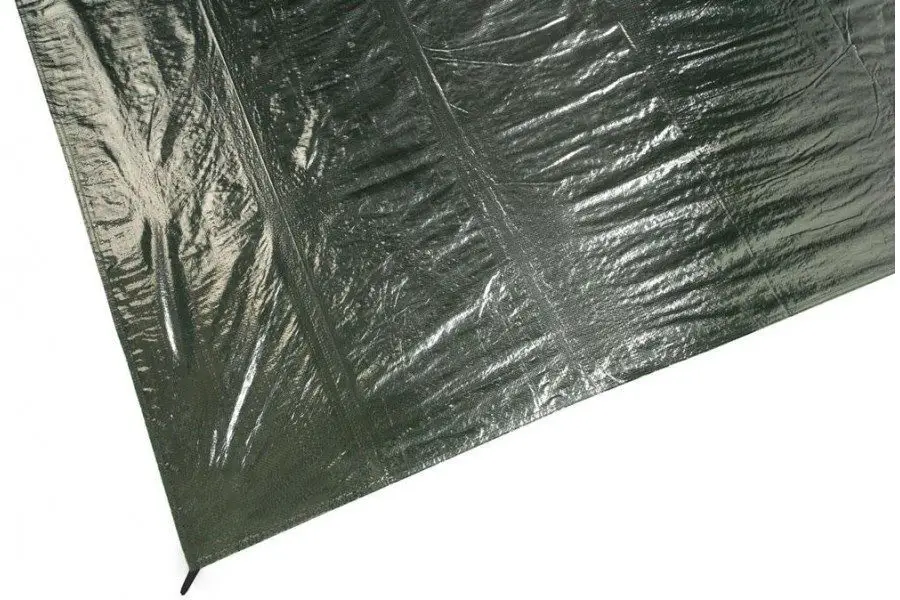Last summer we invested in a new tent to go camping. When researching which tent to buy I saw that there was a tent footprint made specifically for the tent we were buying. Given the amount of money we were investing in the tent, I decided to find out, is buying a tent footprint worth it?
A tent footprint is designed to protect the groundsheet of your tent and tailor-made to fit the shape of your tent. To ensure that you get the longest life possible out of your tent, a tent footprint is an excellent way to ensure that your groundsheet does not wear out too quickly.
Read on to find out more benefits of tent footprints and our tip for saving money.
What is a tent footprint?
A tent footprint is a piece of material that you put on the ground before pitching your tent. Once in place, you can then pitch your tent directly on top of the footprint.
A tent footprint is like the groundsheet of your tent. They come in various shapes and sizes and are often tailor-made to fit the size and shape of your tent.
What are the benefits of a tent footprint?
1. Prolong the life of your tent
As mentioned earlier, a tent footprint will help to prolong the life of your tent.
Your tent’s groundsheet is often subjected to abrasion from contact with objects on the ground, like twigs and stones. Over time this can wear away at the material that your groundsheet is made from and ultimately lead to holes or cuts in the bottom of your tent.
Modern tents are designed with a sewn-in groundsheet, meaning that if you get a hole in the groundsheet, it is possible that you will need to replace the whole tent.
This is where the tent footprint comes in. The footprint acts as a barrier between your sewn-in groundsheet and the ground where you pitch your tent. This means that all the scuffs and cuts will damage the tent footprint and not the sewn-in groundsheet.
The result of this is that you will spend less time repairing your sewn-in groundsheet and hopefully will get you to enjoy your tent for longer.
2. Extra Waterproofing
It’s often rare that we get the chance to pitch our tent on perfectly dry ground. Even when we do, it only takes one spot of rain for the ground to become wet and the bottom of the tent to become damp.
A tent footprint will provide extra waterproofing by acting as the barrier between the bottom of your tent and the ground.
No more damp groundsheet when packing your tent away!
3. It is easier to pack the tent away
Now that your tent hasn’t been in direct contact with the ground, it will be much easier to pack it away as your groundsheet will no longer be wet.
The added bonus of a footprint here is that it can act as a surface to help you fold and roll your tent away, so you won’t have to do it directly on the (potentially) wet ground anymore.
4. Added Warmth
If you’re anything like me, there is nothing worse than being cold when sleeping in a tent.
Your camping mat can often feel cold to sleep on as the coolness of the ground is being transferred from the bottom of your tent, cooling you down in the process.
By adding an extra layer between the ground and you, the result will be a much warmer nights sleep.
5. Tailor made to fit your tent
A tent footprint is tailor-made to fit the shape of your tent. This will help you line up your tent when pitching and stops water collecting between the footprint and the bottom of your tent.
Why you should buy a tent footprint
From the above benefits, you can see that a tent footprint, whilst expensive upfront, can save you money in the long run as it will protect your investment in a tent and also enhance your camping experience.
How to save money on a tent footprint
If you are still unsure about purchasing a tent footprint as you think it is too expensive, you can create your own fairly easily for less money.
What material will I need to make my own tent footprint?
The material used to make a tent footprint can vary. Typically they are made from a lightweight material, such as polythene material, that has been cut and shaped to fit underneath your tent.
Instead of buying a tailor-made footprint like this one which costs £56, simply buy a piece of tarpaulin big enough to fit your tent.
You can buy a tarpaulin from your local DIY store. I did a quick search and found this 8m x 5m tarpaulin from Wickes for only £16. That’s a saving of £40 and you still get the benefit of protecting your sewn-in groundsheet.
What size should the tent footprint be?
As I have mentioned earlier, the carpet needs to be just smaller than the size of your tent. This means that when the footprint is in contact with the groundsheet, water won’t collect between the two layers as it can run off the edges of the footprint.
If your tent footprint was larger than the tent, water could collect between the layers when landing on the overlapping footprint, completely defeating the purpose of having the footprint there in the first place.
Making your own tent footprint
To get the size just right of your footprint, first make sure you buy a piece of tarpaulin that is slightly bigger than the tent is (if you can get a piece smaller be around 10cm that would be perfect, but unlikely).
Next, lay the tent over the top of the tarpaulin, making sure your tent is at its full stretch. You could do this by pitching the tent and pushing the pegs through the tarpaulin at this point as you will be cutting it short.
Once your tent is laid out/pitched, take some scissors and cut the tarpaulin, following the shape of the tent as you go. Try to get close to the tent as possible without cutting it.
Now the tarpaulin is cut to the shape of your tent, you just need to cut the same shape again, but coming in by around 5-10cm.
You have now made your own tent footprint and saved valuable money.
How to clean your tent footprint
Whether you have made your own tent footprint or bought one, you will need to ensure you keep it clean. This is far easier than cleaning a sewn-in groundsheet of a tent.
Simply wipe the material with a wet sponge to remove the dirt on the footprint. You can use more abrasive material, such as a scouring pad if there is a particularly stubborn stain on the footprint, but please be careful not to be too rough as you may damage your tent footprint.
Conclusion
So, is buying a tent footprint worth it? Yes, you should absolutely buy a tent footprint to protect your tent, but whether you buy a bespoke one or simply make one is up to you.

